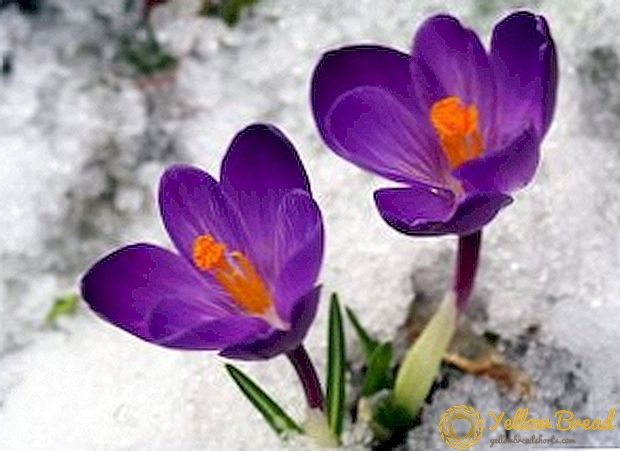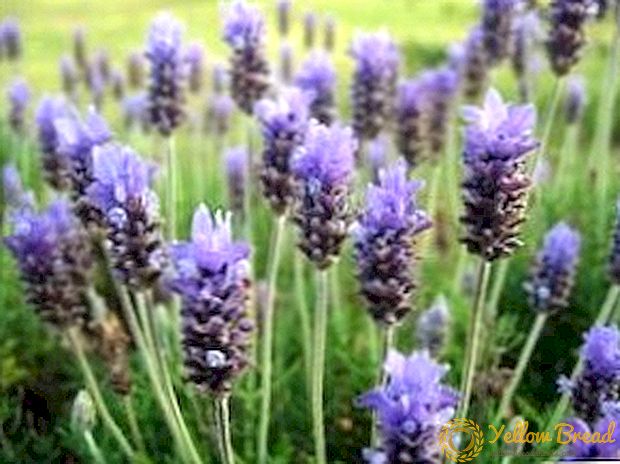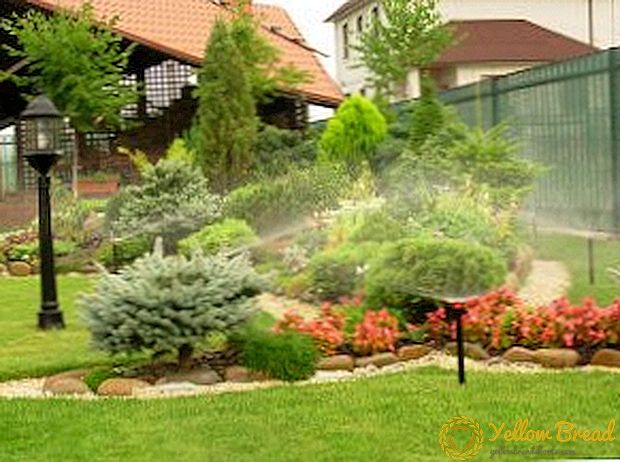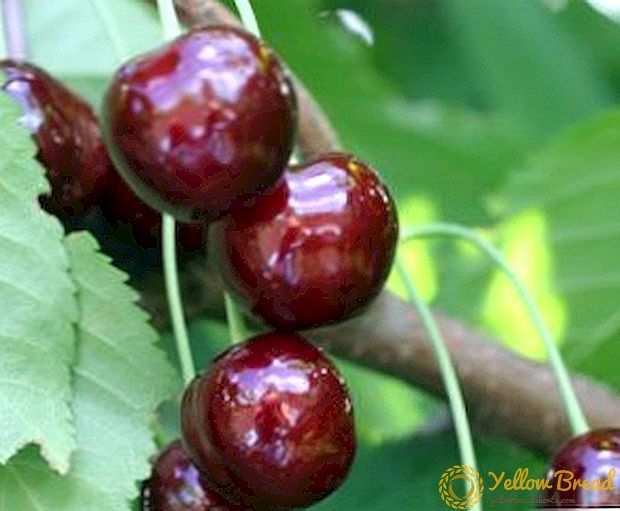 Incredibly beautiful spring flowers - these are crocuses. They begin to bloom in early spring and delight others with their colors up to ten days. After the flowers have faded, the petals are still juicy and fresh, but by the middle of June their turn will also come. Further, the crocus comes a period of rest. In this article we will tell everything that you might be interested about crocuses.
Incredibly beautiful spring flowers - these are crocuses. They begin to bloom in early spring and delight others with their colors up to ten days. After the flowers have faded, the petals are still juicy and fresh, but by the middle of June their turn will also come. Further, the crocus comes a period of rest. In this article we will tell everything that you might be interested about crocuses.
- Crocus or saffron - description
- Choosing a place to plant crocuses
- Are crocuses demanding soil?
- When to plant crocuses
- Spring Crocuses
- Autumn Crocuses
- Crocus planting and propagation
- Crocus seed
- Planting crocuses with bulbs
- Care for outdoor crocuses
- Watering crocuses
- Fertilizer and dressing
- Leaving after flowering
- Crocus Transplant
- Crocus bulb storage
- Crocus seasonal rhythm
- Why crocuses do not bloom
- Crocus diseases and pests
Crocus or saffron - description
Crocus or, as it is even better known by another name, saffron is a bulbous bulbous perennial plant. In the wild, it grows in the steppes, meadows, highlands and rare forests of the Caucasus, Crimea, Asia, the Middle East and southern Europe.Several endangered species of crocuses are listed in the Red Book. Crocus is a beautiful plant, but no matter how desirable it is, it does not bloom too long - only 7-10 days.
 Saffron - This is the scientific name of the flower culture, but in the literature on floriculture, the Latin name Crocus is still distributed. This is a small flower up to 10 cm in height with thin leaves of a linear shape, which are wrapped down. The plant has a different color, but identical bell-funnel-shaped form of flowers. When crocuses bloom, most species bloom in early spring, some in autumn.
Saffron - This is the scientific name of the flower culture, but in the literature on floriculture, the Latin name Crocus is still distributed. This is a small flower up to 10 cm in height with thin leaves of a linear shape, which are wrapped down. The plant has a different color, but identical bell-funnel-shaped form of flowers. When crocuses bloom, most species bloom in early spring, some in autumn.
Flowers appear one, two or three of each bulb. Perianth - segmented in the form of a corolla. Segments grow together into a long tube, which can reach 10 cm in some species. In the absence of the stem, the perianth performs its role and brings the flower to the surface. The segmented appendix consists of six parts, each of which is bent in the upper part. A fully opened bud can reach 8 cm in diameter.
Choosing a place to plant crocuses
Not many people know that crocuses can be divided into autumn and spring, and therefore, planting and caring for them in the open field will differ. When choosing a place for them, keep in mind that the species that are planted in the spring require more sunlight. Autumn crocuses, in turn, are well tolerated by a small shading from coniferous shrubs. We would like to note that in the shade many of the goblet flowers of saffron are not fully revealed, but here, for example, Sharoyan’s autumn crocus blooms much worse under the rays of the sun than in shading.
 Crocuses look very harmonious among the greenery of a grassy lawn, but you should refrain from choosing such a place. And that's why. Lawn grass requires regular mowing, and thus it is possible to accidentally damage the foliage of saffron. As a result, corm will not fully mature.
Crocuses look very harmonious among the greenery of a grassy lawn, but you should refrain from choosing such a place. And that's why. Lawn grass requires regular mowing, and thus it is possible to accidentally damage the foliage of saffron. As a result, corm will not fully mature.
From an aesthetic point of view, the cultivation of crocuses in the country is better organized in groups. In addition, the greatest naturalness is achieved if the bulbs are planted at different distances from each other,imitating a spontaneous natural cycle. To create a solid flower covering of crocuses, they need to be planted on a 3x3 cm grid. Per 1 square meter. m should go at least 50 bulbs.
In this case, as a public flower garden, you should plant the first crocus at the starting point of the edge - the fence, for example. Saffron goes well with summer bulbous plants or annuals. It is not recommended to plant it among perennial crops, because the period of their active development falls on the digging and transplanting of bulbous tubers. Crocuses in rock garden look spectacular. After they bloom, bare ground can be covered with small creeping annuals.
Are crocuses demanding soil?
 Due to the fact that crocuses are autumn and spring, shadow and light-loving, a reasonable question arises as to whether there are universal grounds where all species of this plant are planted. In fact, there are no special requirements for the soil. Any domesticated ones are suitable, but the most comfortable for development will be light and rich in humus.Saffron like a well-moistened, loose and generously fertilized with organic soil. But, like all bulbous plants, water can die from stagnation.
Due to the fact that crocuses are autumn and spring, shadow and light-loving, a reasonable question arises as to whether there are universal grounds where all species of this plant are planted. In fact, there are no special requirements for the soil. Any domesticated ones are suitable, but the most comfortable for development will be light and rich in humus.Saffron like a well-moistened, loose and generously fertilized with organic soil. But, like all bulbous plants, water can die from stagnation.
If, however, clay soils predominate on your site, then, in order to grow healthy and beautiful crocuses, care should be started with soil refining. It is necessary to add peat and sand to clay substrates and fertilize well with organic substances. On 1 square. The following materials are being introduced.: 20 kg of peat or humus, 100 g of bone meal and 50-70 g of fertilizer based on trace elements.
When to plant crocuses
Most flower growers mistakenly believe that crocuses are exclusively flowering plants in the spring, so they are surprised and said: "We plant crocuses only in the fall". When buying planting material, be sure to consider one important fact: there are also autumn species that are planted in spring. This characteristic plays a significant role, since the development cycles of autumn and spring bulbotubes do not coincide. This is an important point when taking into account and determining landing terms.
 In qualified flower shops and at exhibitions, planting stock for crocuses blossoming in the autumn is sold with the mark "Crocus autumn flowering". Spring-flowering can also be purchased in ordinary markets. Of course, in the flower shop you will be picked up with the highest quality varietal material, but, oddly enough, those crocuses, whose bulbs are bought from natural markets, take root, and growing them will not take special care.
In qualified flower shops and at exhibitions, planting stock for crocuses blossoming in the autumn is sold with the mark "Crocus autumn flowering". Spring-flowering can also be purchased in ordinary markets. Of course, in the flower shop you will be picked up with the highest quality varietal material, but, oddly enough, those crocuses, whose bulbs are bought from natural markets, take root, and growing them will not take special care.
Spring Crocuses
In spring-flowering crocuses, the annual cycle of development begins in March (there are some species in which even in February) with the growth of the first leaves. For a more stable and rapid development of plants need to know how to feed the crocuses in the spring. For them, fertilizers based on phosphorus and potassium. They can be made when the first shoots appeared, then during the flowering period and at the end, when the flowers have faded.
 Thus, you contribute to the proper formation of corm and sufficiently feed it. A little later, in the month of April, flowers appear and bloom. When crocuses bloom, the buds open alternately within two to three weeks. At the end of flowering leaves continue to grow until ripening seeds. By the end of June they dry up.
Thus, you contribute to the proper formation of corm and sufficiently feed it. A little later, in the month of April, flowers appear and bloom. When crocuses bloom, the buds open alternately within two to three weeks. At the end of flowering leaves continue to grow until ripening seeds. By the end of June they dry up.
All these processes occur exclusively due to the nutrients in the corm that have been accumulated over the past year. When the bulb is exhausted, it dies off. Crocuses form a new bulb on top of an old one when the flowering time has passed. It will become substitute. It has buds of buds for the renewal of flowers and leaves.
Over the next period of growth and withering away of the leaves, the bulb will already accumulate the necessary energy. Somewhere in the middle of June, the corm will enter tranquility mode, and by the autumn it will act again: it will grow roots and continue the process of accumulating food. Next, the process of bud formation and the resumption of harvesting of future parts of the plant will be fully completed.
 Do not remove the leaves prematurely and do not repot the plant during the growing season, so as not to wrestle with why crocuses did not bloom in spring. This disrupts the life rhythm of the crocus and leads to developmental delay.The bulbs themselves do not die of this and eventually recover, blooming again. But rehabilitation can take two years, but during this time you can forget about the planting material and accidentally dig it up.
Do not remove the leaves prematurely and do not repot the plant during the growing season, so as not to wrestle with why crocuses did not bloom in spring. This disrupts the life rhythm of the crocus and leads to developmental delay.The bulbs themselves do not die of this and eventually recover, blooming again. But rehabilitation can take two years, but during this time you can forget about the planting material and accidentally dig it up.
It is obvious that the cultivation of a plant is directly related to the ripening of the bulb, and this implies that the crocus must preserve the integrity of its leaves until wilt. Therefore, you need to help the flower in every way by removing the boxes with seeds that weaken the corm, and planting the material before the end of the dormant period. The best time to plant spring saffron is September, because a little while later small roots will appear on the bulbs, which are easily injured.
Autumn Crocuses
 The life cycles of the crocus blooming in spring are similar to the periods of the colchicum. They are often confused. In order to avoid an error, you should know that the saffron bulbs are much smaller - up to 2.5 cm and three stamens in the flower, when the colchicum has twice as many. Most of the autumn crocus begins its life cycle with flowering.
The life cycles of the crocus blooming in spring are similar to the periods of the colchicum. They are often confused. In order to avoid an error, you should know that the saffron bulbs are much smaller - up to 2.5 cm and three stamens in the flower, when the colchicum has twice as many. Most of the autumn crocus begins its life cycle with flowering.
During this period, leaves are growing and replacing corm is born. Some produce leaves with a seed box and complete the formation of a new bulb by the spring, when the species described earlier begin to bloom. Crocuses, blooming in late autumn, go for the winter, and did not finish flowering. As a result, no seeds are formed. But this does not weaken the plant and should not cause concern.
Autumnal crocuses have a dormant period of a month earlier than spring, and therefore the peak of bulgarian activity falls in August. Therefore, for the normal development of autumn crocuses in the same year, they should be planted between the end of July and mid-August. But why do not bloom crocuses that are purchased in a good store and planted in properly fertilized soil? The acquisition of already flowering crocuses or delays in planting dates will adversely affect the formation of future plant organs.
 Late-planted crocuses in the first two years only grow leaves and do not bloom. Transplanted crocuses with leaves and flowers fade quickly and enter the two-year recovery period. Crocuses that have successfully passed the life cycle, weaken greatly and should receive appropriate care after flowering. This will fuel their energy for the next year.
Late-planted crocuses in the first two years only grow leaves and do not bloom. Transplanted crocuses with leaves and flowers fade quickly and enter the two-year recovery period. Crocuses that have successfully passed the life cycle, weaken greatly and should receive appropriate care after flowering. This will fuel their energy for the next year.
Crocus planting and propagation
The reproduction of crocuses involves two ways: seeds and daughter corms. This is not a complicated process at all.
Crocus seed
Growing crocuses from seeds is practiced much less frequently than from corms. This practice is inherent in gardeners who want to propagate some valuable plant species, so the planting material is taken in large quantities.
 Most botanical crocuses do not have problems with seed formation, but only in the autumn the fruiting cycle can be lost due to the onset of early frost. Planting material is well preserved, but in the case of species blooming in the autumn, it is better to sow only the collected seeds for overwintering.
Most botanical crocuses do not have problems with seed formation, but only in the autumn the fruiting cycle can be lost due to the onset of early frost. Planting material is well preserved, but in the case of species blooming in the autumn, it is better to sow only the collected seeds for overwintering.
Since the stratified material germinates better, perfectly healthy and stronger crocuses can be grown from these seeds. Future crocuses harvested with seeds give very small shoots, and since the weeds do not sleep, it is better to plant them in containers or boxes from the beginning. Until the first shoots appeared, the seed containers should be covered with a light-protective film or spunbond. In the second case, watering can not be carried out. Seedlings will begin to bloom in 3-4 years.
Planting crocuses with bulbs
Digging corms every winter is not necessary. It is necessary to do this every three-year-old in the summer period of rest of crocuses, in order to separate the parent bulb from the growing tubers during this time. They can be up to ten pieces, and they begin to interfere with each other.
 As a result, saffron flowers are significantly reduced in size. In this case, the separation of daughter bulbs, their transplantation and further care for crocuses are done as follows. To collect plant material in the form of corms, the mother plant can be dug more often than once every three years. It is better to disturb autumn blooming saffron from June to August, and spring flowering from July to September. Planting material must be removed from the ground, dried, removed defective scales and dead roots.
As a result, saffron flowers are significantly reduced in size. In this case, the separation of daughter bulbs, their transplantation and further care for crocuses are done as follows. To collect plant material in the form of corms, the mother plant can be dug more often than once every three years. It is better to disturb autumn blooming saffron from June to August, and spring flowering from July to September. Planting material must be removed from the ground, dried, removed defective scales and dead roots.
You should also carefully examine the bulbs for diseases. Leave only healthy stuff. Mechanical damage should be healed with ash or crushed coal. Until they are planted in the ground, they should be stored in a dry and cool place.
Care for outdoor crocuses
How to grow crocuses strong and healthy after planting, we will tell further. But know that you will not spend much effort and a lot of time.
Watering crocuses
 Regularly there is no need to water saffron, besides, it is very painful for stagnant moisture. Many crocuses need water in spring and autumn flowering periods. But nature helps us there too: in one case, the snow melts and gives water, in the other - the autumn rains. Additional watering is organized if the winter was not snowy, and autumn is not rainy enough. But even with insufficient moisture, crocuses successfully go through a vegetative period. Only in height they will be less. In summer, during periods of tranquility, crocuses do not need water; they prefer to rest in a dry environment.
Regularly there is no need to water saffron, besides, it is very painful for stagnant moisture. Many crocuses need water in spring and autumn flowering periods. But nature helps us there too: in one case, the snow melts and gives water, in the other - the autumn rains. Additional watering is organized if the winter was not snowy, and autumn is not rainy enough. But even with insufficient moisture, crocuses successfully go through a vegetative period. Only in height they will be less. In summer, during periods of tranquility, crocuses do not need water; they prefer to rest in a dry environment.
Fertilizer and dressing
The basis of growing all the plants in the garden is top dressing, therefore, thinking about how to grow healthy and beautiful crocuses in your garden, you need to prepare a complex of mineral fertilizers. Feeding crocuses has some of its nuances. Fresh organic fertilizers are not allowed. They cause various diseases.Peat, fully decomposed manure and other mineral fertilizers will be preferred.
In early spring, during the period of active growth, fertilizer should be sprinkled over the melting snow. With the beginning of the vegetative period, you can enter urea. Later, an excess of nitrogen will cause a sharp growth of leaves, which will cause undesirable fungal diseases in wet weather. After half a month, it is necessary to introduce fertilizers rich in phosphorus and potassium to the landing site. They will contribute to better flowering and the formation of strong and healthy corm.
Leaving after flowering
 Like many bulbous, these flowers lose their leaves by the middle of summer, so you need to be especially careful in caring for crocuses at your summer house after they bloom. If you do not have plans to transplant plants to a new place, then you can get by removing faded foliage. If it was decided to dig crocuses, then the best time is July.
Like many bulbous, these flowers lose their leaves by the middle of summer, so you need to be especially careful in caring for crocuses at your summer house after they bloom. If you do not have plans to transplant plants to a new place, then you can get by removing faded foliage. If it was decided to dig crocuses, then the best time is July.
The procedure is as follows:
- Remove the inflorescences that have faded so that the plant does not go to extra effort to try to form seeds.
- Gradually reduce the amount of watering. So the outflow of all nutrients will gradually go into the corm.
- When the leaves become completely yellow, the onion should be dug out and dried a little at room temperature.
- Next, remove the scales and discard sick and damaged tubers.
- Store the bulb in a well-ventilated room at a temperature of 20 ° C.
Crocus Transplant
Due to the abundant formation of daughter bulbs in crocuses, they need to be seated. Otherwise, a large nest of processes is formed. They become crowded, they become deformed, the flowers become smaller, and the plant loses its aesthetic appeal.
The bulbs need to be dug up after the leaves have completely died off in mid-July - early August. Store before transplanting in a warm, well ventilated area. It is necessary to plant in flower beds in August or September at a distance equal to two or three corns diameter from each other. The hole must be dug to a depth equal to three bulbs in height.
Crocus bulb storage
 Extracted corms need to be cleared from the ground, dead roots and scales, and then spread out in one layer in a box or box. The smallest can be decomposed, for example, in candy boxes.Until August, planting material should be kept at a temperature of +22 ° C and not lower, since it is in this mode that the flower buds are laid. In August, the temperature should be lowered to +20 ° C. In a week - up to +15 ° С. But such conditions are difficult to create at home, and they are ideal, because it is only in specialized farms that you can adjust the thermal regime. In habitual conditions for us, crocus bulbs should be placed in a dark dry place with the possibility of good ventilation and room temperature.
Extracted corms need to be cleared from the ground, dead roots and scales, and then spread out in one layer in a box or box. The smallest can be decomposed, for example, in candy boxes.Until August, planting material should be kept at a temperature of +22 ° C and not lower, since it is in this mode that the flower buds are laid. In August, the temperature should be lowered to +20 ° C. In a week - up to +15 ° С. But such conditions are difficult to create at home, and they are ideal, because it is only in specialized farms that you can adjust the thermal regime. In habitual conditions for us, crocus bulbs should be placed in a dark dry place with the possibility of good ventilation and room temperature.
Crocus seasonal rhythm
Spring flowers, crocuses can begin to bloom both in mid-March and mid-April, provided that you grow them taking into account all the nuances. But the timing of this event can vary considerably depending on the melting of the snow and the warming up of the soil cover. There have been cases of the start of flowering spring crocuses, even in late February.
Autumn species are more stable and constant in this case.The quality of the vegetative period depends directly on the conditions in which the recovery bud was formed last season - this applies to spring flowering or this summer - autumn flowering saffron.
Why crocuses do not bloom

Many amateur gardeners and growers are wondering why crocuses do not bloom, when everything seemed to be done right, but in fact there is no flower and there is only one leaf. Let's deal with this problem together and decide for what reasons?
First, what can negatively affect flowering is the thickening of the plantings. It becomes so close to the daughter bulbs that the mother tuber is able to push out only new feathers of young green leaves from the ground. The bulbs interfere with each other, so the flowering is out of the question. The way out is obvious here - plant crocuses and give more space to new tubers.
The second reason may be covered in too deep planting bulbs. They just do not have enough energy to bloom. All the forces they spent on punching sheets through the ground. Often, bulbous plants that are planted in sandy soil involuntarily delve into a loose substrate.
You can remedy the situation by transplanting the corms to a depth of 7 cm. In heavy clay soils, onions need to be deepened by no more than 5 cm.
 The final reason why crocuses do not bloom in your garden, there is a lack of fertilizer primer. The main thing is to make mineral-based preparations in a timely manner and in the required quantities. First, it is done during planting: fertilizer is applied directly to the hole. Saffron, which has been growing in one place for many years, draws all the nutrients out of the soil. These flowers must be fed in the spring, watering a solution of mineral fertilizers. Organic fertilizers are also suitable, the best of which is compost introduced into the planting hole.
The final reason why crocuses do not bloom in your garden, there is a lack of fertilizer primer. The main thing is to make mineral-based preparations in a timely manner and in the required quantities. First, it is done during planting: fertilizer is applied directly to the hole. Saffron, which has been growing in one place for many years, draws all the nutrients out of the soil. These flowers must be fed in the spring, watering a solution of mineral fertilizers. Organic fertilizers are also suitable, the best of which is compost introduced into the planting hole.
Crocus diseases and pests
 No matter how hard you try to take care of your garden, grow crocuses or other bulbous crops, but sometimes something goes wrong. The plant either stops at one stage of development, or loses its aesthetic appearance, or dies at all.
No matter how hard you try to take care of your garden, grow crocuses or other bulbous crops, but sometimes something goes wrong. The plant either stops at one stage of development, or loses its aesthetic appearance, or dies at all.
The reasons for this are diseases and pests:
- Viruses. The first sign of their appearance on saffron is white spots on the deformed leaves. They stretch and spin at the tips. They are carried by sucking insects, such as aphids, mites or thrips. The affected plant already becomes by default a distributor of the infection, and it must be immediately destroyed. But do not worry if the disease mowed rare crocus on your site. The viruses do not reach the seeds, and the plant can be revived by reseeding. Let it take some time, but you will get your flower pets back.
- Fungi. Activated in warm and wet weather. As a rule, they are affected by the corm of the plant. It loses its density, shrivels, and stains of unnatural color form under the scales. Such a bulb must be destroyed, and other children to dry in a cool place. Before planting, they should be soaked in a weak manganese solution or a 0.2% solution of "Fundazol".
- Chlorosis. In this disease, the leaves begin to turn yellow, which is caused not by the lack of any nutrients in the soil, but by mechanical damage to the tuber, poor drainage or inappropriate growing conditions.
- Mice and moles. They damage the corms, breaking through their passages and even taking them entirely to their homes or nibbling on roots. If the plant grows poorly, weakly blooms, then it is possible to judge that the onions have rotted. In this case, they need to dig out and remove the rotten part. Treat the cut sites with ashes and leave in the open air for several hours to dry. In order not to attract mice, you need to remove all dead wood and grass within a radius of three meters from the landings, because the mice nest there. Further than three meters from the nest, they will not run away.
- Caterpillars butterflies-scoop. Gnaw the roots and make holes in the bulbs. They can be recognized in the fall when weeding. When these large gray insects prepare to pupate, they can be easily dug up, collected and destroyed.
- Slugs On fertile or heavy clay soils underground slugs settle. You can get rid of them with the help of a special solution of slugs or, when planting around a bulb, make an improvised sandy cocoon.






